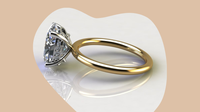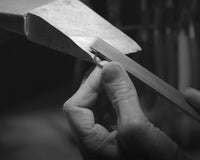Sapphire vs Diamond Engagement Rings
For some years now, diamonds have been the go-to choice for engagement rings. Brides-to-be across the globe often dream of the big and brilliant ‘Rock’ that will one day grace their finger.
However, a style that has remained a close second are sapphire engagement rings. And that’s long before Kate Middleton’s revival of Princess Diana’s iconic, and equally as stunning, sapphire piece.
So, if you’re on the hunt for an engagement ring, whether it’s for a surprise proposal or you’re helping your partner find the perfect ring, you might find yourself wondering whether to choose a diamond or sapphire for the centerpiece of your design.
Fortunately, we are here to help. We’ve put the two precious stones head to head to help you come to the right decision, by weighing up hardness, quality, cost and more. Read on to discover which style is best for you, and then browse our collection to find a ring that ticks every box.
Head to Head - Diamond vs Sapphire
|
Diamond engagement rings |
Sapphire engagement rings |
|
|
Formation |
Formed deep within earth’s crust under intense heat and pressure conditions that causes carbon atoms to crystalise |
Formed deep within earth’s crust during the transformation and cooling process of igneous rock. Sapphire is gem quality corundum |
|
Hardness |
10/10 on Mohn hardness scale |
9/10 on Mohs hardness scale |
|
Cut |
Available in a variety of cuts, designed to show off the stones’ brilliance and fire and preserve carat weight |
Available in a variety of cuts, designed to show off the stones’ colour and preserve carat weight |
|
Clarity |
Graded on a scale of flawless to included, flawless being the most desirable but rare |
Inclusions are common and expected |
|
Colour |
Colourless diamonds are most valuable, but fancy coloured diamonds are also available |
Blue sapphires are most desirable. Sapphires are available in almost every shade, other than red |
|
Price |
Diamonds are the most valuable precious gemstone, but budgets can be met by widening your choice of carats, clarities and colours |
Blue sapphires are most valuable. White sapphires can be chosen as a budget friendly alternative to diamonds |
-
Hardness
An engagement ring is designed to be worn day in and day out for the rest of your life with your partner. Therefore, it’s important that the materials the ring is crafted from are durable and robust in order to handle daily knocks and contacts that could otherwise damage the precious piece of jewellery.
Both diamonds and sapphires are graded on their durability using the ‘Mohs’ scale of mineral hardness. Diamonds come out on top, with a grade of 10, which is at the highest end of the spectrum. However, sapphires are not far behind, holding an impressive grade of nine.
Although diamonds are technically more durable, sapphires can only be scratched by a mineral that is harder than them. Therefore, the only way a sapphire engagement ring will scratch is if it is stored with diamond or moissanite jewellery, as these are the only two stones graded higher than sapphire on the Mohs scale. If your engagement ring is kept and cared for mindfully, there is no reason a sapphire ring won’t remain as scratch-free as a diamond one.
-
Quality
When spending a significant sum of money on an engagement ring, it’s only natural to want the best quality for your budget. The GIA provides a universally accepted framework for assessing the quality of Diamonds, which is called the 4C’s model. This comprises cut, colour, clarity and carat.
Sapphire engagement rings can be assessed on similar characteristics, with the one caveat of clarity, which is less relevant for sapphires than it is for diamonds. Clarity refers to the number of inclusions or imperfections present in a stone. In diamonds, these can significantly impact the brilliance and appeal of the stone, whereas in sapphires and other coloured gemstones, inclusions are common and expected.
Similarly, although the cut of both diamonds and sapphires is important, you will ultimately be assessing different factors when determining quality. For diamonds, brilliance and fire are key and the way in which a stone is cut can significantly impact the way in which it interacts with and disperses light. Therefore, a high quality diamond is one that has been cut in a way that showcases the best brilliance and fire.
Sapphires however, are not desired for their sparkle alone. The cut of a sapphire is more concerned with showcasing the stone’s colour in the best possible way as this is what is appealing about the precious gemstone.
It is possible to find high quality diamonds and sapphires in engagement rings. As both types of stone are assessed on different factors, you simply cannot say one is a better quality than the other. It’s essential both are considered independently when determining quality.
-
Versatility
When shopping for an engagement ring, it is likely you will find yourself inundated with options. And this has a lot to do with the versatility of the types of stones used in ring designs. While sapphires and diamonds are both versatile stones, they are so in different ways.
Diamonds are available in a number of different cuts, carats, colours, clarities and settings. However, some styles are more popular than others - for example a round brilliant cut with diamond halo.
White diamonds are also the most common type of stone used in engagement rings, although they are available in a variety of other colours, including yellow, pink, black and more. Due to the rarity of these coloured, or ‘fancy’ diamonds, their prices tend to be higher, making them less accessible to some couples.
Sapphires on the other hand are known and admired for their versatile colour range. It is possible to find sapphires in every shade of colour, other than red. Red stones formed in the same way as sapphires are called rubies.
Blue sapphires are by far the most popular, but even these are available in a spectrum of hues, tones and intensities.
Therefore, for those looking for an engagement ring with a splash of colour, we would most certainly recommend a sapphire style, while for those who want to keep it simple and stick to a classic design, diamonds may be the better option.
-
Cost
Cost is an important factor when shopping for an engagement ring, with many couples working with a very specific budget. When you begin your search, you will soon realise that diamond rings are much more expensive than sapphire ones. This is largely due to their stature, rarity and value, all of which are larger or more significant than a sapphire’s.
That’s not to say sapphires are not a desirable or worthy centerpiece for your engagement ring. Often, couples find that they can get a higher quality and larger stone within their budget with a sapphire, while the diamonds available at their price point are smaller, with inclusions and are not entirely colourless.
Ultimately, it depends on what you place the greatest importance on - if it’s price, then a sapphire engagement ring is the one to choose.
Alternatively, you can opt for a laboratory grown diamond engagement ring, rather than an earth mined one as this is another way to save costs. Lab grown diamonds can be priced up to 50% less than natural diamonds, providing couples with a greater chance of finding their dream ring.
-
Desirability
Undeniably, both diamonds and sapphires are a more than suitable choice for an engagement ring. Both possess a number of unique and desirable characteristics, so the choice really just comes down to personal preference.
There are plenty of famous faces and influential figures who sport both types of ring, meaning neither is more or less desirable than the other. If you are still undecided, you can book a no-obligation, free of charge consultation with our experts, during which we will understand your individual needs and even present a few options to consider.
If you’ve set your sights on a particular type, you can browse our collections of diamond and sapphire engagement rings online today.


